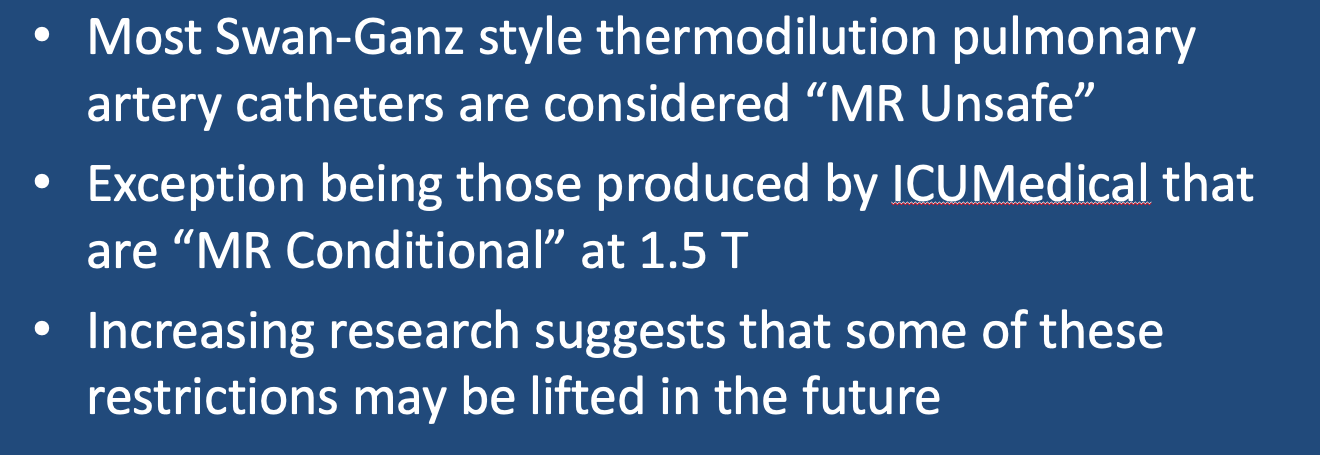The "infamous" case about which you are referring took place in 1988 and was reported only as a brief abstract to an independent safety organization. A portion of a triple-lumen Swan-Ganz thermodilution catheter outside the patient "melted" during MR imaging. No further details are available, including field strength, SAR levels of the pulse sequences employed, or whether the catheter had a looped wire or other configuration that predisposed it to heating.
 "MR Unsafe" Swan-Ganz® thermodilution catheter with tip in right lower lobe pulmonary artery.
"MR Unsafe" Swan-Ganz® thermodilution catheter with tip in right lower lobe pulmonary artery.
Swan-Ganz and similar catheters are inserted via a large vein, passed through the right heart, to finally rest in a pulmonary artery. The original Swan-Ganz devices had two lumens and balloon at the distal tip for floating the catheter out peripherally. Later models added more lumens (for drug administration), a temperature sensor (for thermodilution measurement of cardiac output), a fiber-optic probe (for measuring ventricular myocardium oxygen saturation), and even electrodes (for right-sided pacing).
Edwards Lifesciences holds copyright to the brand name "Swan-Ganz®" (including those with all the special ad-on's listed above). Swan-Ganz® catheters containing temperature sensors and electrodes are considered MR Unsafe. Other Edwards pulmonary artery catheters, including those without including those used exclusively for oximetry (PediaSat®) or pressure measurements are MR Safe (provided the external cables and monitors are removed).
Edwards Lifesciences holds copyright to the brand name "Swan-Ganz®" (including those with all the special ad-on's listed above). Swan-Ganz® catheters containing temperature sensors and electrodes are considered MR Unsafe. Other Edwards pulmonary artery catheters, including those without including those used exclusively for oximetry (PediaSat®) or pressure measurements are MR Safe (provided the external cables and monitors are removed).
Several other companies (e.g., Deroyal, Braun) produce similar "Swan-like" pulmonary artery thermodilution catheters but do not provide MR safety guidance. These devices by default must be considered MR Unsafe. However, ICUMedical offers a full range thermodilution and advanced sensor pulmonary catheters that are rated as MR Conditional at 1.5T.
Although we are obliged to follow the conventional wisdom and avoid scanning most patients with Swan-Ganz and similar thermodilution devices, don't be surprised if a reversal of this thinking occurs in the next several years. (For example, many legacy pacemakers previously considered MR Unsafe are now considered relatively safe to scan under specific conditions.) Removing and re-inserting thermodilution catheters is not trivial and carries with it a risk, so some researchers (see references) are actively re-evaluating the situation.
Advanced Discussion (show/hide)»
Although no further details of the 1988 case are available, two more recent documented cases illustrate certain similarities. In one, melting of the tip of an intracranial pressure catheter occurred when MR conditional limits were exceeded; in another, a skin burn occurred when a PTCA containing a braided wire was used off-label as a biliary drainage device.
References
ECRI Institute. Health devices alert: a new MRI complication? May 27, 1988
Huber W, Minning A, Sakka S, et al.: Is magnetic resonance imaging (MRI) feasible with an indwelling transpulmonary thermodilution catheter: data from an observational analysis and from a survey. Intensive Care Medicine Experimental 2015 3(Suppl 1):A612.
Masaki F, Shuhei Y, Riko K, Yohiro M. Iatrogenic second-degree burn caused by a catheter encased tubular braid of stainless steel during MRI (letter). Burns 2007; 33:1077-9. [DOI LINK]
Shellock FG, Shellock VJ. Cardiovascular catheters and accessories: Ex vivo testing of ferromagnetism, heating, and artifacts associated with MRI. J Magn Reson Imag 1998; 8:1338-1342.
Tanaka R, Yumoto T, Shiba N, et al. Overheated and melted intracranial pressure transducer as cause of thermal brain injury during magnetic resonance imaging. J Neurosurg 2012; 117:1100-1109.
Voet M, Overduin CG, Still EL, et al. Safety aspects of the PiCCO thermodilution‑cardiac output catheter during magnetic resonance imaging at 3 Tesla. J Clin Monitor Comput 2021 (in press). [DOI LINK]
ECRI Institute. Health devices alert: a new MRI complication? May 27, 1988
Huber W, Minning A, Sakka S, et al.: Is magnetic resonance imaging (MRI) feasible with an indwelling transpulmonary thermodilution catheter: data from an observational analysis and from a survey. Intensive Care Medicine Experimental 2015 3(Suppl 1):A612.
Masaki F, Shuhei Y, Riko K, Yohiro M. Iatrogenic second-degree burn caused by a catheter encased tubular braid of stainless steel during MRI (letter). Burns 2007; 33:1077-9. [DOI LINK]
Shellock FG, Shellock VJ. Cardiovascular catheters and accessories: Ex vivo testing of ferromagnetism, heating, and artifacts associated with MRI. J Magn Reson Imag 1998; 8:1338-1342.
Tanaka R, Yumoto T, Shiba N, et al. Overheated and melted intracranial pressure transducer as cause of thermal brain injury during magnetic resonance imaging. J Neurosurg 2012; 117:1100-1109.
Voet M, Overduin CG, Still EL, et al. Safety aspects of the PiCCO thermodilution‑cardiac output catheter during magnetic resonance imaging at 3 Tesla. J Clin Monitor Comput 2021 (in press). [DOI LINK]
Related Questions
Any special precautions in patients with vascular access ports?
Any special precautions in patients with vascular access ports?
